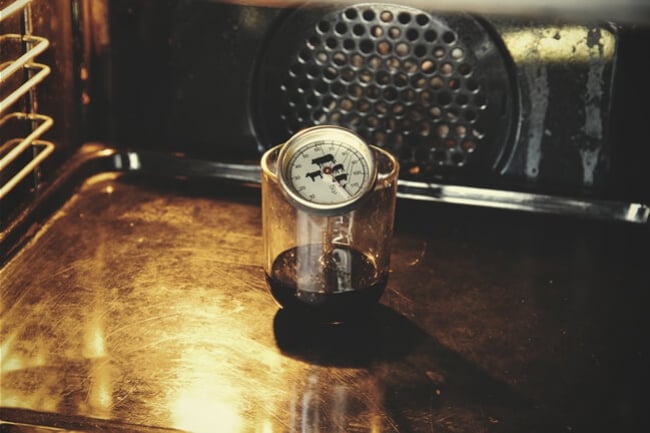.
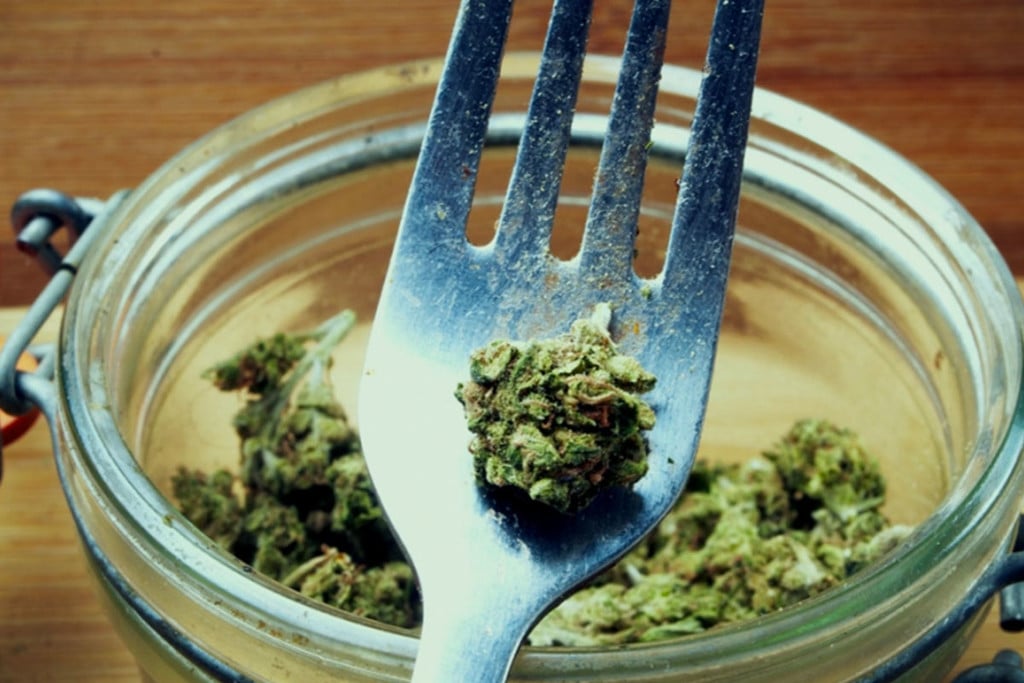
The Therapeutic And Dietary Benefits of Eating Raw Cannabis
Cannabis is as much a vegetable as many of the plants we throw in our food every day. In fact, weed qualifies as a superfood in its own right! Packed with beneficial phytochemicals rarely found elsewhere, raw cannabis flowers and leaves add a healthy punch to salads, smoothies, and juices. Discover the benefits of eating raw cannabis below.
Discover the benefits of eating raw cannabis.
Contents:
Move over kale and spinach—marijuana is the new superfood! When we get down to the root of the situation, cannabis is technically a vegetable, even though it's not often viewed as such. Most cannabis users are familiar with the effects of smoking, vaping and consuming edibles, but have you ever wondered if eating raw weed leaves is ok? From a nutritional perspective, cannabis packs a plethora of healthy molecules, including:
- Protein
- Fibre
- Antioxidants
- Vitamins
- Minerals
The thought of chewing through a pile of fresh buds and leaves might be a turn-off. However, they can be used in nourishing salads and juices that are surprisingly pleasant on the palate.
Benefits of Eating Raw Cannabis
Smoking, vaping and cooking weed all affect the chemical composition to some degree. Some of these changes create beneficial chemical reactions, whereas others are detrimental. Many of the vital molecules within cannabis—namely terpenes and cannabinoid acids—are volatile and sensitive to high temperatures. Consuming raw cannabis keeps these compounds in their natural state, allowing users to access those phytochemicals that disappear or change when smoked.
Consuming raw cannabis enables users to stimulate their endocannabinoid system—a regulatory network that keeps the body in balance—without getting high or having to inhale anything in the process. Raw cannabis could very well become a popular functional food of the future.
Cannabinoid Acids
Raw cannabis contains very different molecules to those inhaled after combustion or vaporisation. THC, CBD and other cannabinoids don’t actually exist in raw cannabis. Instead, they’re packed with their chemical precursors—cannabinoid acids. Cannabinoid acids feature a carboxyl group that is lost after being exposed to heat, a process known as decarboxylation. For example, non-psychoactive THCA converts to psychoactive THC, and CBDA converts to CBD.
Cannabis scientists have discovered that these chemicals possess their own unique benefits compared to their post-decarboxylation counterparts. Check out the below lists of properties to learn what the main cannabinoid acids have to offer.
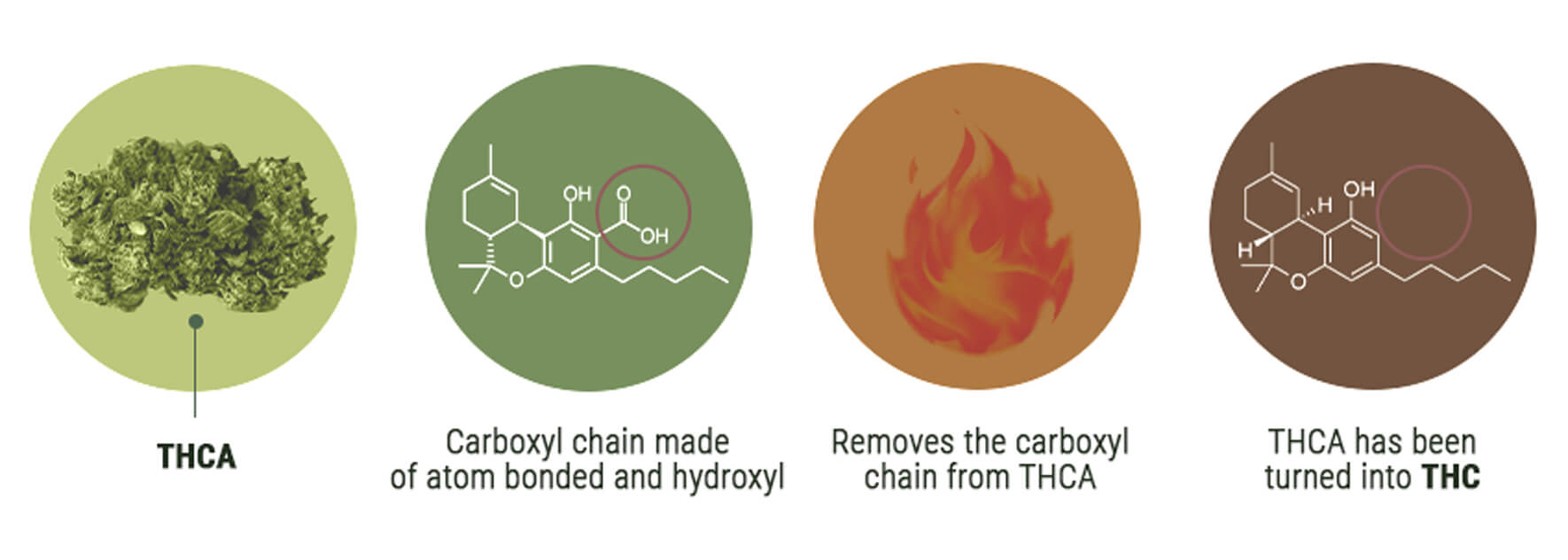
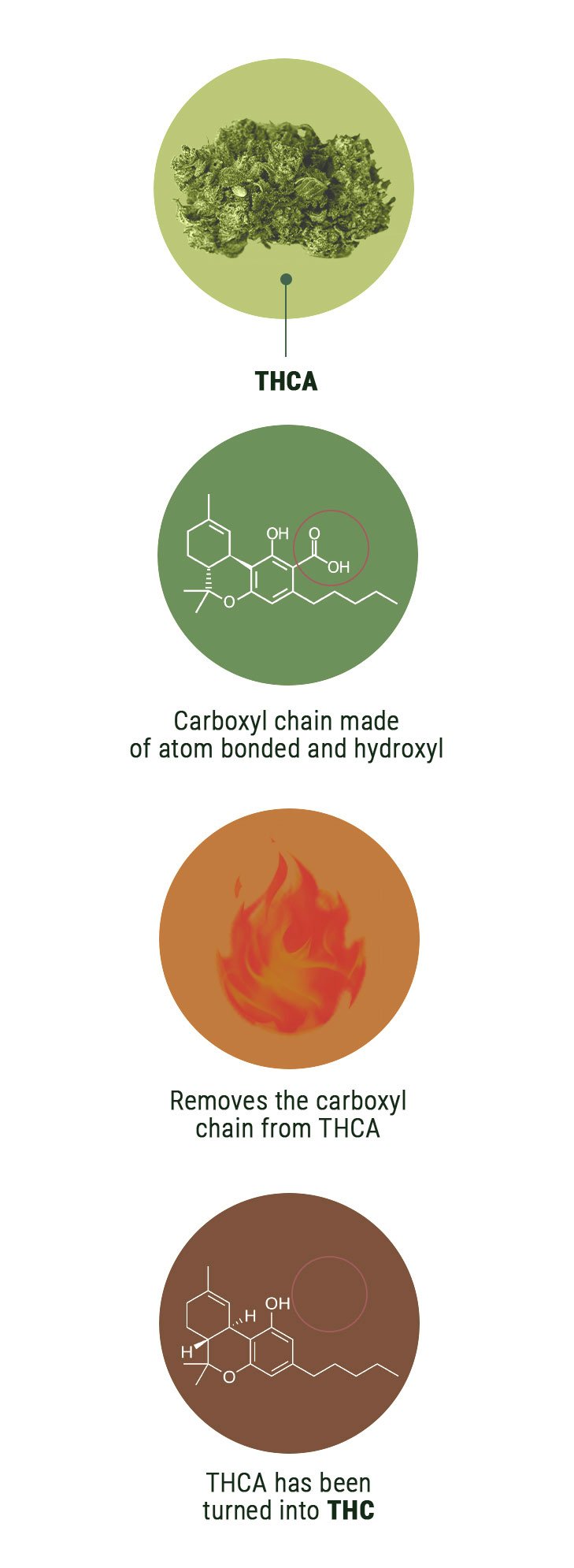
-
Non-psychoactive, because it does not bind to the CB1 and CB2 receptors
- Boosts endocannabinoid production
- Binds to enzymes involved in the cyclooxygenase pathway (responsible for inflammation), reducing the effects of inflammation
- May relax an upset stomach, symptoms of IBS, and obesity-induced digestive inflammation
- Has the potential to inhibit the proliferation of cancerous cells
- May be an effective neuroprotectant against neurodegenerative diseases
CBDA[2]:
- Non-psychoactive
- Boosts endocannabinoid production
- May elevate the mood, more so than CBD
Terpenes
These aromatic molecules underpin the signature scent of cannabis. Not only are they responsible for the delicious flavour of certain strains, but they also modulate the cannabis high through the entourage effect[3]. Different terpenes interface with different cannabinoids to augment their effects.
Terpenes also produce effects entirely on their own. For example, limonene[4] and myrcene[5] induce a relaxing response that can enhance the feeling of wellbeing.
Because terpenes are volatile and degrade at high temperatures, you won’t enjoy nearly as many when you smoke. However, raw cannabis flowers are chock-full of these fascinating molecules. Consuming cannabis raw keeps terpenes in their natural state. Researchers are still figuring out exactly how terpenes survive digestion, but we know at least some of these molecules make it through into the blood.
Flavonoids
Flavonoids usually fly under the radar when it comes to weed-related discussions. Cannabis smokers are often more preoccupied with cannabinoid and terpene profiles. The flavonoids, however, are a significant factor . These diverse phytochemicals are found in a range of superfoods, from kale and broccoli, to berries and tea.
Flavonoids play an important role in cannabis plants. These pigments colour plant tissue in order to attract pollinating species, and also to protect plants from UV rays and pathogens. Specific flavonoids found in cannabis include:
- Cannflavin A
- Cannflavin B
- Kaempferol
- Quercetin
- Anthocyanins
These often overlooked phytochemicals offer an impressive array of potential health benefits,
such as:
- Antioxidants effects
- Supports the heart
- Can help clean arteries
This impressive chemical profile shows cannabis is as healthy as any other vegetable, making it a perfect addition to any salad, smoothie or juice.
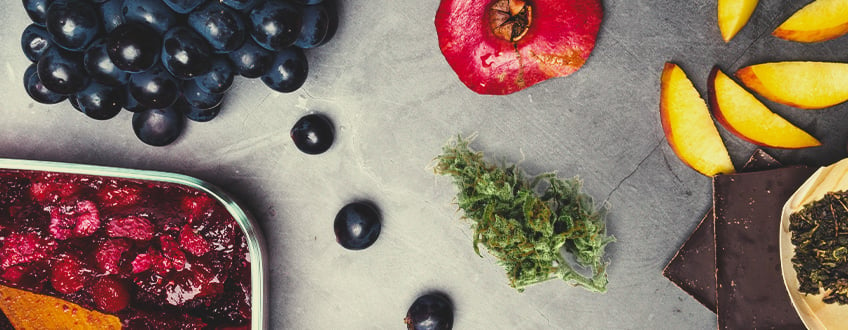
What Qualifies as Raw Cannabis?
Just like any other raw vegetable, raw cannabis means the buds and leaves are fresh and untampered with. Prior to being exposed to heat, these parts of the plant maintain their natural biochemistry and offer a different experience to smoking and cooking weed. Even letting cannabis dry and sit for too long will degrade cannabinoids and terpenes. In turn, it could possibly reduce the benefits received from consuming freshly picked flowers and leaves.
To classify as raw cannabis, these parts should not be:
- Cooked
- Steamed
- Smoked or vaped
- Dried
Can You Get High From Eating Raw Cannabis?
So, would munching on these leaves get you high? In short, No.
See, fresh, raw cannabis doesn’t contain THC, but is instead packed with THCA. That cannabinoid acid only converts to psychoactive THC after heat-induced decarboxylation. THCA can also break down into THC through exposure to UV rays and ageing—though these buds aren’t truly “raw”.
Potential Downsides of Raw Cannabis
Of course, eating almost any food raw comes with an element of risk. When it comes to cannabis, chowing down on raw leaves can expose diners to potentially harmful bacteria—both salmonella and E. coli have been found on cannabis samples. Some growers also use chemical pesticides on their crop to keep pests at bay. Although effective, these substances can leave a residue behind on flowers and leaves that tastes awful and hurts our bodies
To make sure you stay safe when consuming raw cannabis, only consume cannabis you know hasn’t been treated with these chemicals. In turn, make sure it hasn’t been grown with the help of potentially harmful products like manure.
Methods of Consumption
The sheer diversity of consumption enables cannabis smokers and vapers to enjoy a huge assortment of pipes, bongs, extracts, concentrates, vaporizers and bubbles. The same level of variety makes consuming raw cannabis just as pleasant and fun. Far from chewing on raw leaves—though an easy and surprisingly tasty option—consuming raw cannabis takes many forms. Check out some of the most popular methods below.
Smoothies
Smoothies provide a tasty and easy way to load up on phytonutrients. Add raw cannabis flowers and leaves to your smoothies for a dose of cannabinoid acids and terpenes. Throw in some tropical fruits, berries and ice for unrivalled taste and freshness. Check out the Royal Queen Seeds’ cannabis smoothie for a recipe that will light up your taste buds and endocannabinoid system simultaneously.

Juicing
At Royal Queen Seeds, we consider juicing the best way to consume raw cannabis. This method concentrates all of the good stuff—cannabinoids, terpenes and flavonoids—while leaving the unnecessary (and sometimes difficult to digest) fibre behind. Use freshly harvested raw cannabis to make a powerful shot of phytochemicals, or add the juice into smoothies.

Salads
Who said salads have to be boring? Thinly chop some fresh cannabis leaves and sprinkle them into a bowl loaded with spinach, onions, radishes, olives and peppers. Add some chicken or sunflower seeds for extra protein and crunch, and tuck in!

Hemp Seeds
Don’t forget about the seeds! Hemp seeds are loaded with nutrients, and add a moreish nutty flavour to any dish. Sprinkle them onto pasta, salads, puddings and even cereal. These little spheres of goodness pack high levels of omega fatty acids, essential amino acids, calcium, iron, and fibre!

Cold-Pressed Hemp Seed Oil
Lastly, cold-pressed hemp seed oil condenses the benefits of hemp seeds into a tasty oil. Use this delicious oil for cooking, or add a dash over salads for that lovely nutty taste.

- Tetrahydrocannabinolic acid is a potent PPARγ agonist with neuroprotective activity https://www.ncbi.nlm.nih.gov
- Cannabis Pharmacology: The Usual Suspects and a Few Promising Leads - PubMed https://pubmed.ncbi.nlm.nih.gov
- Taming THC: potential cannabis synergy and phytocannabinoid-terpenoid entourage effects https://www.ncbi.nlm.nih.gov
- (PDF) Physiological and psychological effects of olfactory stimulation with D-Limonene https://www.researchgate.net
- Myrcene - an overview | ScienceDirect Topics https://www.sciencedirect.com






























